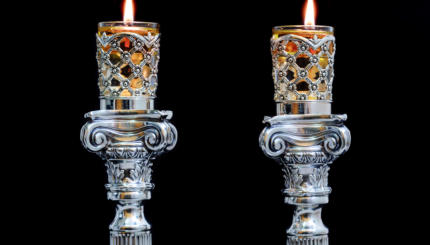Excerpted with permission from Celebration and Renewal: Rites of Passage in Judaism edited by Rela Mintz Geffen (Jewish Publication Society).
Strictly speaking, a legitimate Jewish wedding has two fundamental requirements: First, both parties must enter the marriage voluntarily and willingly; second, their marriage must be accompanied by a ketubah. The term ketubah, which comes from the Hebrew verb “to write,” refers to the traditional marriage document, in use since rabbinic times. The traditional ketubah stipulates the obligations that the husband takes on vis-à-vis his bride during marriage, as well as his financial obligations in the case of divorce.
Over the course of marriage, the husband traditionally has three primary obligations to his wife: He must provide her with food, clothing, and sexual satisfaction. Food and clothing, of course, represent the basic economic necessities of life, and the clear implication of the traditional ketubah text is that the husband will effectively provide for his wife’s economic well-being. In the case of divorce, the ketubah requires the husband to pay the wife a sum of money, which is dependent on her marital history prior to the current marriage [that is, whether she is a virgin, a divorcée, or a convert].
 Because the traditional ketubah text assumes that it is the husband who will provide for the wife, this document has come under attack by those seeking greater equality between men and women. Before briefly addressing the substance of this critique and the suggestions for making the ceremony more egalitarian, a word about the original intentions of the ketubah is in order.
Because the traditional ketubah text assumes that it is the husband who will provide for the wife, this document has come under attack by those seeking greater equality between men and women. Before briefly addressing the substance of this critique and the suggestions for making the ceremony more egalitarian, a word about the original intentions of the ketubah is in order.
Ketubah Originated as a Protection for Women
Though clearly the respective roles of the bride and groom as stated in the ketubah are not equal, it must be stressed that, far from being an intentionally misogynist document, the ketubah was originally created to protect women from being simply discarded by their husbands with no provision for their economic welfare. To that extent, the ketubah, despite its dated perception of social reality, was not a tool of repression, but actually a liberating document for women. The ketubah was considered so basic to a just marital relationship, in fact, that the Talmud commented that the fundamental distinction between a wife and a concubine was that a wife had to be given a ketubah, while a concubine did not. The rabbis further stipulated that a man was forbidden from living with his wife, even for one hour, without a ketubah.
Modernists Unhappy With Ketubah
These comments on the history and intent of the ketubah do not satisfy most couples who wish to equalize their roles in marriage. These couples, as well as many rabbis and feminist thinkers, point to several distinct difficulties with the traditional ketubah text:
1. the lack of mutuality, given the dramatically changed social and economic circumstances of women today;
2. the reference in the document to the woman’s previous marital status–and specifically to the usual use of the term betultah, or “virgin,” as it is commonly translated, to refer to a previously unmarried woman–with no mention made of the man’s marital or sexual history; and finally,
3. the one-sided focus on financial issues.
Potential Solutions
The two most obvious solutions to these objections are to do away with the ketubah altogether, or to revise it. While the Orthodox community continues to use only the standard text, practices in the other movements vary. Some Reform rabbis have simply dispensed with a ketubah, and many Reform and liberally inclined Conservative rabbis also use nontraditional texts, pointing out that no single ketubah text was ever adopted universally by all Jewish communities. Research into ancient ketubot has shown, for example, that some traditional communities avoided making any reference to the bride’s marital or sexual history, while others used terms such as penita (unmarried), thus avoiding the issue of virginity.
Similarly, although Maimonides claims that a nonvirgin must be identified as such by use of the term be’ultah (married woman), other equally significant sources deny this. In the Talmud, Rabbi Meir suggests that the classification of the bride ought not depend on her physical virginity but on whether her societal attractiveness has been affected in any way. And Rabbi David Hoffmann, the leading light of German Orthodoxy at the end of the 19th century, urges that if a woman is not a virgin, no term be used to designate her.
Some communities also sought to include in the ketubah some mention of nonfinancial elements of the marriage; one ancient ketubah has been located in which the groom declares his bride to be not simply “my wife” but “my friend and my wife in covenant” (ha-veirati ve-eshet beriti).
Today, many liberally inclined Jews who still elect to use a ketubah make much more significant changes in the text, usually omitting virtually all financial elements of the document and ensuring that obligations be assumed by both partners. Those who choose to use nontraditional marriage documents often do so fully cognizant that they thereby depart radically from tradition and that no halakhically [Jewish legally] sanctioning community stands behind these new texts. Rather than emulating the public nature of the traditional text, these tend to be rather private documents, expressing the feelings and commitments of the couple rather than the communal nature of the institution of marriage that is implied by use of the traditional text.
Proponents of these new texts further argue that even if more traditional communities reject the legitimacy of creative ketubot, that rejection will have no bearing on a couple’s marital status. Because Jewish law effectively recognizes common-law marriage, even the most traditional communities, they assert, need to recognize these arrangements as marriage, even if a ketubah is not included. The argument for the new marriage documents, despite their lack of universal acceptance, has been voiced most eloquently by Rabbi Daniel Leifer [a Conservative Hillel rabbi who was an early supporter of the havurah movement]:
“Those who think that they can achieve major halakhic change within the existing Jewish community will perhaps be disappointed by my perspective. I believe, however, that those who are struggling to change Orthodox halakhah and/or the minds of the traditional Orthodox decision-makers are wasting their time and energy. It is my conviction that change is effected through the creation of new alternative and rival Jewish rituals and halakhic forms which will ultimately effect and bring about change in the traditional forms and the traditional community.”
Addressing the Agunah Problem
Before concluding our discussion of the ketubah, mention of another common emendation to the traditional text is in order. This emendation addresses the ever-vexing ethical problem of the agunah, the Jewish woman whose husband refuses to grant her a religious divorce. In response to this agonizing dilemma, the Conservative movement began widespread use of an additional clause [in the ketubah] written by the eminent Talmudic scholar Dr. Saul Lieberman. The “Lieberman clause,” as it is known, stipulates that the bride and groom agree that their lives will be conducted according to Jewish law and that, in the event of a divorce, they agree to follow the dictates of a given beit din (Jewish court).
Thus, if the husband refuses to issue a get (a traditional Jewish writ of divorce), the beit din will order the husband to do so; if he refuses, the theory goes, his wife can petition a secular court to compel the husband to issue a get or else find him in breach of a contract, namely, the ketubah he signed at the time of his marriage.
The Reform movement has not adopted any parallels to the Lieberman clause, because that movement does not require a get for the dissolution of [a marriage]. In the Orthodox community, where the problem of the agunah is unfortunately a serious one, [halakhic prenuptial agreements are being promoted by some prominent Orthodox rabbis].
We also recommend this video from our friends at G-dcast:
ketubah
Pronounced: kuh-TOO-buh, Origin: Hebrew, the Jewish wedding contract.
Talmud
Pronounced: TALL-mud, Origin: Hebrew, the set of teachings and commentaries on the Torah that form the basis for Jewish law. Comprised of the Mishnah and the Gemara, it contains the opinions of thousands of rabbis from different periods in Jewish history.


